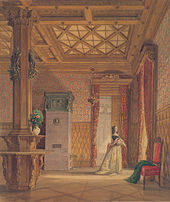Palais Schönborn-Wiesentheid
The Palais Schönborn-Wiesentheid was a city palace in Munich . It was also known at times under the name Palais Cramer-Klett , was destroyed in the Second World War and rebuilt in a simplified manner in the 1950s.
history

In June 1843, Reichsrat Count Damian Hugo Erwein von Schönborn-Wiesentheid acquired the previous building on Ottostraße from the property of the treasurer and landowner Ludwig Ritter von Mann-Tiechler . As the architect for the city palace to be built, he commissioned thirty-year-old Franz Jakob Kreuter with one of the largest private construction projects of the mid-century in Munich. Kreuter's plans were carried out from 1843 to 1846.
In 1877 the entrepreneur Reichsrat Theodor von Cramer-Klett acquired the Schönborn Palace, in whose last years the house was modified by the Munich builder Albert Schmidt according to plans by the Nuremberg architect Adolf Gnauth . At the time of Maria Almas-Dietrich's art gallery , von Cramer-Klett's son, the landowner and entrepreneur Theodor Freiherr von Cramer-Klett junior lived here with his wife, a servant and a porter. In addition, the Swiss consulate and a technical consortium GmbH had their headquarters in the building.
Shortly before the beginning of the war in 1941, the Munich Tourist Office and the embassies of Switzerland and the United States were located in the traditional house. The house owner was now Anna Freifrau von Cramer-Klett, "landowner and factory owner widow." On April 25, 1944, the house was bombed during the great air raid on Munich. Maria Dietrich and the “Almas” gallery moved to the Gustav-Freytag-Straße 5 building.
In June 1948, the Baugesellschaft des Bayerisch-Württembergischen Handwerks mbH submitted plans for reconstruction on behalf of Ludwig Freiherr von Cramer Klett . A restaurant was planned on the ground floor. By 1952, the remains of the damaged building were removed and rebuilt in a simplified manner. The house number subsequently changed from 9 to 19.
architecture
The facade of the three-storey hipped roof building was - similar to that of the Palais Dürckheim - clad with color-coordinated clinker brick slips in the neo-renaissance style. The street front was sculpted with pilaster strips , window frames and reliefs made of sandstone . The stately building related to Maximiliansplatz and the Maxtor . Three balconies , a loggia and a winter garden gave expression to the idea of a garden city beyond the old ramparts. The historically designed furnishings included mosaic floors, marble stairs, frescoes, wall coverings made of silk and damask. A watercolor by Eduard Gerhardt captured the furnishings in the Bernhardinen-Saal.
Painting collection
Reichsrat Count Damian Hugo Erwein von Schönborn-Wiesentheid had married Countess Sophie von Eltz in 1832 and inherited his important painting collection after the death of his father Franz in 1840. It went back to the Prince-Bishops Lothar Franz and Friedrich Karl von Schönborn . Works by Rembrandt , van Dyk , Peter Paul Rubens , Teniers , Cranach , Albrecht Dürer , Tizian , Giorgione , Tintoretto and Ribera , which could compete with the royal collection, came from Pommersfelden to Maxvorstadt in Munich. "A more elaborate collection of paintings from more recent times will hardly be found in a count's palace and therefore all art lovers consider them a highlight of the city."
Individual evidence
- ↑ Christoph Hölz: The civil engineer Franz Jakob Kreuter. Tradition and modernity 1813–1889. Berlin 2003, p. 125.
- ↑ Munich City Address Book 1926, p. 605
- ^ Munich city address book 1941, p. 480
- ^ Entry on Palais Schönborn-Wiesentheid in the private database "Alle Burgen". Retrieved June 27, 2016.
- ↑ Report on the Bamberg Art Association from its creation on December 12, 1823 to 1843 . Bamberg 1843, p. 12. [1]
- ^ Carl Friedrich Kunz, Emanuel Feust, Panorama of Bamberg: The latest guide through the city and its surroundings . Bamberg 1842, p. 79. ( digitized version )
- ^ The painting gallery of Count Schönborn-Wiesentheid in Munich . In: Münchener Kunst-Anzeiger for artists, art lovers and art dealers. Munich 1865, p. 51. ( digitized version )
Coordinates: 48 ° 8 ′ 35.8 " N , 11 ° 34 ′ 17.8" E

